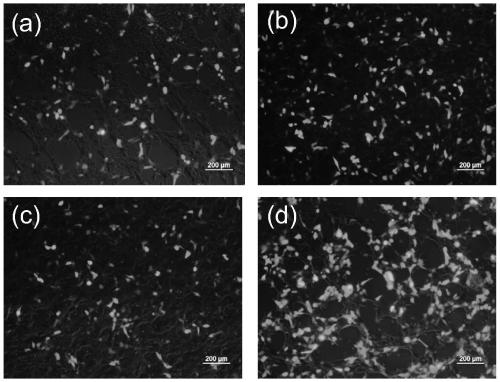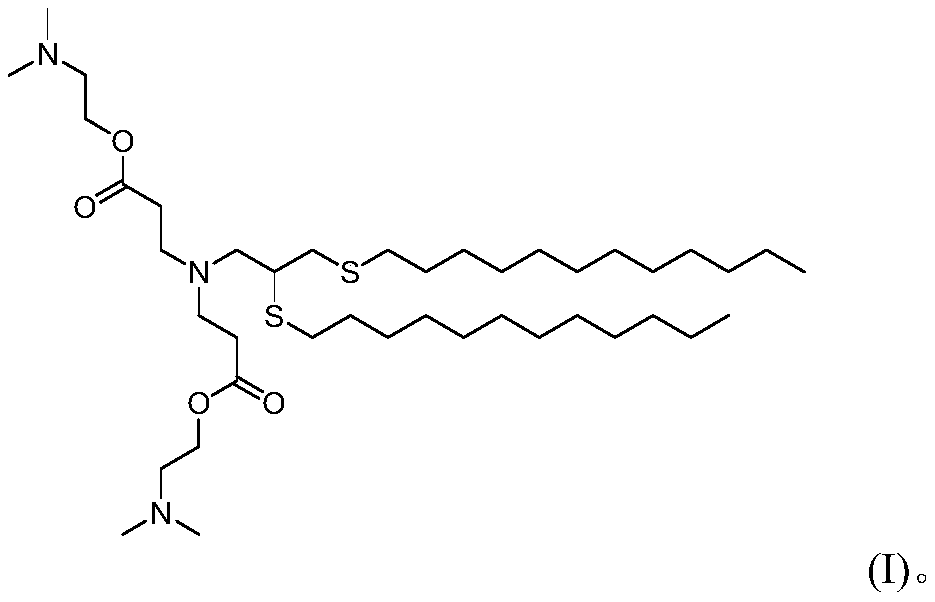Cationic amino lipid as well as synthesis method and application thereof
An amino lipid and cation technology, applied in the field of cell transfection, can solve the problems of limiting the application range of liposome transfection reagents, high production and R&D costs, ineffective transfection, etc., so as to reduce production costs and improve production. rate, the effect of reducing the difficulty of the reaction
- Summary
- Abstract
- Description
- Claims
- Application Information
AI Technical Summary
Problems solved by technology
Method used
Image
Examples
Embodiment 1
[0027] A cationic amino lipid, the structural formula of the cationic amino lipid is as shown in formula (I),
[0028]
[0029] The synthetic method of above-mentioned cationic amino lipid comprises the following steps:
[0030] Step 1. propargylamine and lauryl mercaptan are added in the tetrahydrofuran solution with the mol ratio of 1:1.5, and the solution concentration of final reactant total amount is 30mg / mL, then add free radical photoinitiator, described free radical The photoinitiator is benzoin dimethyl ether, and the addition amount of the free radical photoinitiator is 1% of the total mass of the reactants. After purging nitrogen to remove oxygen, it is placed under ultraviolet light for 1h. The wavelength of ultraviolet light is 250nm, and the intensity is 3mW / cm. Obtain compound (II)
[0031] Step 2. Add dimethylaminoethyl acrylate to the solution that has been reacted in step 1. The mol ratio of dimethylaminoethyl acrylate and propargylamine is 1:1, and the...
Embodiment 2
[0033] A cationic amino lipid, the structural formula of the cationic amino lipid is as shown in formula (I),
[0034]
[0035] The synthetic method of above-mentioned cationic amino lipid comprises the following steps:
[0036] Step 1. Propargylamine and dodecyl mercaptan are added in the dichloromethane (DCM) solution with the molar ratio of 1:2, and the solution concentration of final reactant total amount is 500mg / mL, then add free radical photoinitiator , the free radical photoinitiator is benzoin dimethyl ether, and the addition amount of the free radical photoinitiator is 5% of the total mass of the reactants. After nitrogen deoxygenation, it is placed under ultraviolet light for 3h. The wavelength of ultraviolet light is 365nm, and the intensity Be 0.5mW / cm, obtain compound (II)
[0037] Step 2. Add dimethylaminoethyl acrylate to the solution that has been reacted in step 1. The molar ratio of dimethylaminoethyl acrylate and propargylamine is 2:1, and then add an...
Embodiment 3
[0039] A cationic amino lipid, the structural formula of the cationic amino lipid is as shown in formula (I),
[0040]
[0041] The synthetic method step of above-mentioned cationic amino lipid is as follows:
[0042] Step 1. Synthetic 2,3-bis(dodecyl sulfide)-propylamine (compound (II) ), 0.5mmol propargylamine and 1mmol dodecyl mercaptan were dissolved in 3mL THF (tetrahydrofuran), and then 5mg free radical photoinitiator benzoin dimethyl ether (DMPA) was added, and transferred to a 20mL glass vial, and nitrogen gas was removed After oxygenation for 5 minutes, place the glass bottle under 365nm UV light for 1 hour, and the reaction formula is as follows:
[0043]
[0044] Step 2. Add 1mmol dimethylaminoethyl acrylate to the glass vial after the reaction in step 1, stir evenly, add 0.1mmol alkaline substance 1,8-diazabicycloundec-7-ene, and stir overnight . Then the solution is poured into a 25mL single-necked flask, and THF (tetrahydrofuran) is evaporated to obtain...
PUM
| Property | Measurement | Unit |
|---|---|---|
| Wavelength | aaaaa | aaaaa |
Abstract
Description
Claims
Application Information
 Login to View More
Login to View More - R&D
- Intellectual Property
- Life Sciences
- Materials
- Tech Scout
- Unparalleled Data Quality
- Higher Quality Content
- 60% Fewer Hallucinations
Browse by: Latest US Patents, China's latest patents, Technical Efficacy Thesaurus, Application Domain, Technology Topic, Popular Technical Reports.
© 2025 PatSnap. All rights reserved.Legal|Privacy policy|Modern Slavery Act Transparency Statement|Sitemap|About US| Contact US: help@patsnap.com



